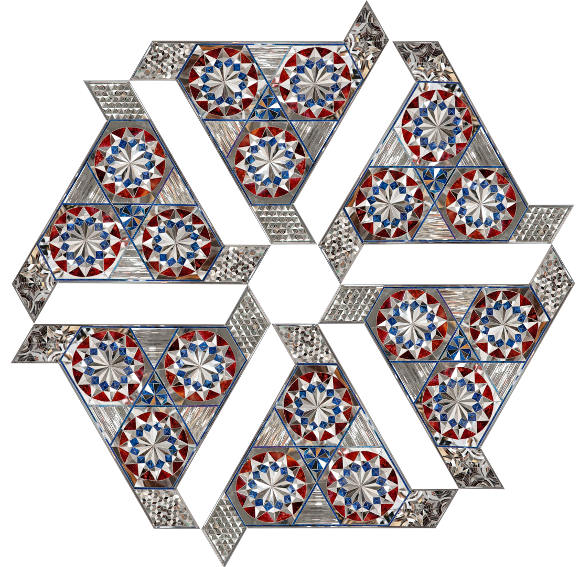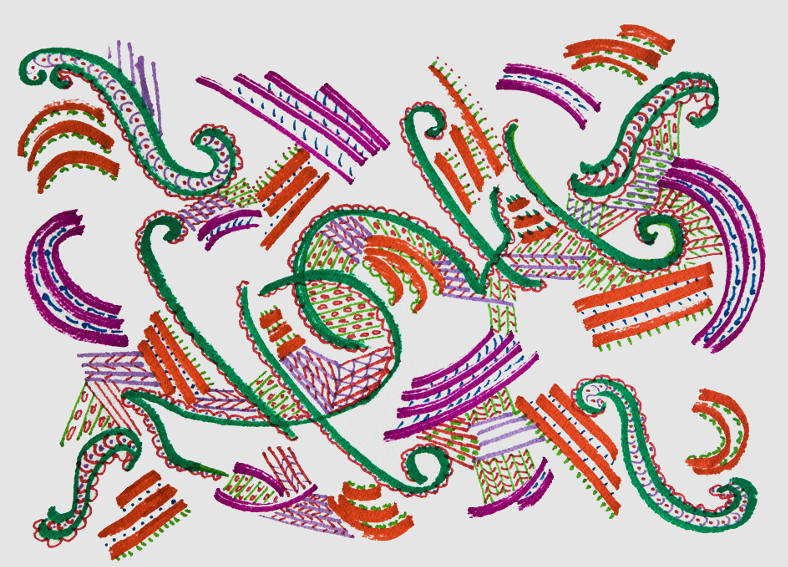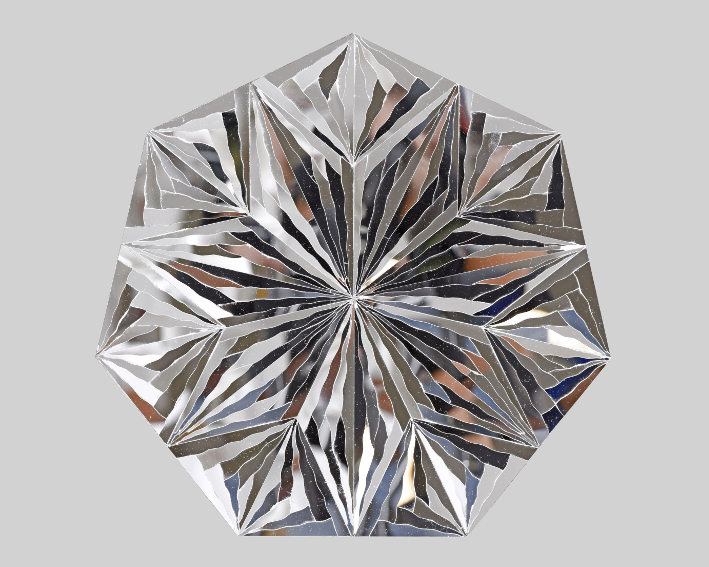
The Kaleidoscopic Nature of Monir Shahroudy Farmanfarmaian’s Art
It may not be obvious to many people at first why Sunset, Sunrise, the first international retrospective of the work of Iranian artist Monir Shahroudy Farmanfarmaian, is being held at the Irish Museum of Modern Art (IMMA) in Dublin. We are told every day by politicians and pundits that contemporary Iranian culture is somehow fundamentally different than that of Europe and the rest of the world. But to Farmanfarmaian, the connection between Iran and Ireland makes perfect sense. “The Irish and the Iranians share a love of poetry in their cultures,” she says. “My poetry is in my art.” It is encouraging in this time of apparent divisiveness to see artists and institutions so willing to rise above the political fray. For its part, the IMMA has demonstrated its progressive ideals repeatedly in recent years, hosting a series of exhibitions that spotlight influential, but overlooked female artists such as Etel Adnan and Hilma af Klint. Farmanfarmaian is the perfect addition to that esteemed group. The poetry in her art connects cultures, nations, and epochs of history. It is the fruit of a universal, humanitarian world view that touches the shores of the United States, Europe and the Middle East. Meanwhile, the techniques she employs connect the distant folk traditions of the past with ideas from the vanguard of contemporary abstract art. At age 94, Farmanfarmaian is an excellent ambassador for our common ground. Her unique aesthetic position reveals an essential truth of our time: that there are more similarities than differences between the aesthetic traditions of our too often divided world.
Middle East Meets East Coast
Farmanfarmaian has always been a pioneer. She recently claimed the honor of being the first female artist ever to be celebrated in Iran with a museum dedicated solely to her work: the Monin Museum in Tehran. Farmanfarmaian donated 50 of her own works to its collection, stating, “My love for my culture is in everything I create.” This accomplishment is reminiscent of when, after beginning her art studies at the Fine Arts College of Tehran, she was amongst the first Iranian students to be allowed to travel to the United States to study after the end of World War II. She ended up staying in the U.S. for 12 years, from 1945 through 1957, spending most of that time in New York City, where she interacted with some of the most influential American artists of that generation, including Jackson Pollock, Andy Warhol, and Louise Nevelson. Movements as diverse as Pop Art, Abstract Expressionism and Minimalism affected her emerging visual ideas. After returning to Iran, she began exploring how these international positions fit in with the ancient aesthetic traditions of her home culture.

Monir Shahroudy Farmanfarmaian, Group 9 (Convertible Series), 2010, Mirror and reverse glass
painting on plaster and wood, Variable configurations (150 x 150 cm). Courtesy the artist and The
Third Line, Dubai.
Geometric Abstraction revealed itself to be a natural fit for her, since it shared so many formal qualities in common with the visual language of traditional Islamic art. Also, the calligraphic tendencies of Lyrical Abstraction echoed throughout the aesthetic landscape of Persian art. Farmanfarmaian found a way to connect all of these influences by way of the visual language of the kaleidoscope. Known to Mediterranean cultures since antiquity, the kaleidoscope employs geometrically shaped lenses to create harmoniously balanced, symmetrical compositions similar in many ways to those in a Hindu Mandala. The principal at work in the device is the idea of multiple reflections—a perfect allegory to express a multi-cultural perspective on visual art. Farmanfarmaian embraced and evolved this visual concept, creating a unique abstract method of deploying kaleidoscopic imagery. She built her vision into an oeuvre that seems remarkably modern even today. It encompasses sculptures, reliefs, paintings, jewelry, drawings, textiles and collages, and simultaneously bridges contemporary global abstraction with the ancient roots of Persian culture.

Monir Shahroudy Farmanfarmaian, Untitled (D24), 1993, Felt tip marker on paper, 26 x 36 cm.
Courtesy of the artist and The Third Line, Dubai
Sky Spaces
Sunset, Sunrise at the IMAA includes a selection of more than 70 works. Echoes of the singular vision Farmanfarmaian has developed are evident in each of her drawings, textiles, sculptures, and jewelry. But it is in her mirrored wall pieces that the true depth the work is revealed. Farmanfarmaian is one of the few living artists using a technique known as reverse glass painting. This ancient method involves painting an image in reverse on a piece of glass and then displaying the glass backwards so that the image is right-side up. Farmanfarmaian reverse paints shards of glass and then constructs mosaic compositions out of them. She adds mirrors and glitter to the work, creating pieces that shine and glow in the light. In many cases while touring the IMMA exhibition, dancing geometric light-forms on the floors, ceilings, and walls announce the presence of the materials before the eye has a chance to see the works. The connection to a disco ball is obvious, and a whimsical photo of the artist in her studio in 1975, surrounded by glass-and-mirror covered orbs, drives home that connection even further.

Monir Shahroudy Farmanfarmaian, Untitled (Heptagon), 2016, Mirror and reverse-glass painting on
plexiglas, 33 cm diameter per element, shown as set of five. Courtesy the artist and The Third Line,
Dubai.
The exhibition derives its name from two newer works by Farmanfarmaian, “Sunrise” and “Sunset,” both made in 2015. They feature a circular form in the center of a vertical rectangular field. The mirrors and glass shards within the circles are a mixture of vibrant colors and pale silver. The rest of the surface is covered in mirrored shapes that reflect the light and colors of the surroundings, allowing the viewer to be visible in the work. These pieces are both stunning to behold, and transcendent in their potential. Staring deeply into them, I feel transformed in ways similar to when I visit the Rothko Chapel, or stand inside of a Turrell Skyspace. The message of these works, and of this entire exhibition, is related to cycles: the cycles of history; the cycles of nature; the cycles of art. It is no wonder Farmanfarmaian won the Gold Medal in three of the four Venice Biennales in which she participated. This retrospective serves as a reminder to the rest of the world not only of her value as an artist, but of the connection we share in common with the culture she calls her own. Sunset, Sunrise is on view at the Irish Museum of Modern Art through 25 November 2018.
Featured image: Monir Shahroudy Farmanfarmaian, Untitled (D12), 2015, Felt tip marker and pen on paper, 70 x 100 cm. Courtesy of the artist and The Third Line, Dubai.
By Phillip Barcio






